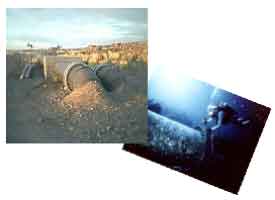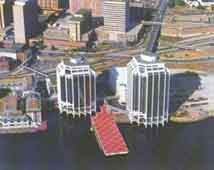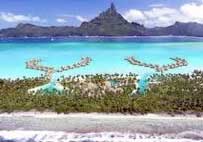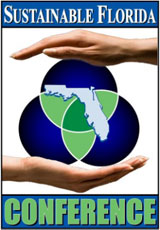
Georges Claude ~ 1929
 Harvesting thermal energy from the ocean traces its roots to 1881 when French physician Jacques-Arsène d’Arsonval first proposed using a heat engine based on the work of Scottish engineer William Rankine. D’Arsonval surmises that “if pumps pull enough water through two separate sets of pipes, the warm seawater will evaporate a heat transfer liquid (such as ammonia or propane) in one part of the plant; elsewhere, cold seawater recondenses the gas to liquid. But as it blows from the first point of phase change to the second, the gas stage will drive a turbine” (Chiles 2008). The physician, turned ocean scientist, knew that coastal areas close to deep cold water and warm surface water could produce power from the temperature difference. Harvesting thermal energy from the ocean traces its roots to 1881 when French physician Jacques-Arsène d’Arsonval first proposed using a heat engine based on the work of Scottish engineer William Rankine. D’Arsonval surmises that “if pumps pull enough water through two separate sets of pipes, the warm seawater will evaporate a heat transfer liquid (such as ammonia or propane) in one part of the plant; elsewhere, cold seawater recondenses the gas to liquid. But as it blows from the first point of phase change to the second, the gas stage will drive a turbine” (Chiles 2008). The physician, turned ocean scientist, knew that coastal areas close to deep cold water and warm surface water could produce power from the temperature difference.
Click to read more...

NELHA ~ 1990
 In 1974, the Natural Energy Laboratory of Hawaii (later named NELHA) was established by the State of Hawaii legislature on a 322 acre area at Keahole Point on the Big Island as a support facility for Ocean Thermal Energy Conversion (OTEC) research. If successful, NELHA would “prove the feasibility and usefulness of OTEC as an alternative non-polluting power source” (“Deep,” 2010). In 1979, the first successful project was an at-sea, closed-cycle OTEC operation conducted aboard the Mini-OTEC, a converted Navy barge operating in waters off Keahole Point, Hawaii. In 1974, the Natural Energy Laboratory of Hawaii (later named NELHA) was established by the State of Hawaii legislature on a 322 acre area at Keahole Point on the Big Island as a support facility for Ocean Thermal Energy Conversion (OTEC) research. If successful, NELHA would “prove the feasibility and usefulness of OTEC as an alternative non-polluting power source” (“Deep,” 2010). In 1979, the first successful project was an at-sea, closed-cycle OTEC operation conducted aboard the Mini-OTEC, a converted Navy barge operating in waters off Keahole Point, Hawaii.
This plant operated for three months and generated up to 55 kW of gross power. About 40 kW were required to pump up 2700 gallons/min of 42°F water from 2200-ft depth through a 24-in diameter polyethylene pipe and an additional 2700 gallons/min of 79°F surface water, leaving a maximum net power output of 15 kW. This preceded a shore based project by NELHA in 1980. On the Big Island of Hawaii, the first shore based series of pipelines was constructed to draw warm surface seawater from 45 feet and deep cold seawater from 2000 feet at Keahole Point and was once used to air condition the facility. The deep ocean pipeline transitions from land under the shore break and then protrudes out the seawall where it is laid at an incline on the seabed down to the 2000 feet.
On a 2009 visit to the NELHA facilities, it was learned that the cold water pipe, which protruded from the seawall under the surf break, was experiencing a warmer water temperature. This change in temperature coincided with a 2006 earthquake in the area. It was speculated that perhaps the earthquake caused a crack in the pipe at the upper portion allowing warmer water to seep in. This speculation has added to the growing concern for the vulnerability of surface laid piping. Natural disasters ranging from hurricanes to earthquakes have the potential to destroy surface laid piping. The innovation herein alleviates this growing concern.
Although there is room for improvement for the overall design of the applications, it must be known that “NELHA is ‘landlord’ to nearly 30 thriving enterprises which generate about $30-40 million per year in total economic impact, including tax revenues, over 200 jobs, construction activity and high value product exports. Two pipeline systems pump deep and surface seawater to shore continuously and a third, the world's largest and deepest (to a depth of 3,000 feet), is being developed now” (“NELHA,” 2010). NELHA is certainly an excellent model for the sustainable future necessary in the 21st century.

The Purdy’s Wharf Complex in Halifax, Nova Scotia
 "In Halifax an innovative cooling system at the Purdy’s Wharf office and commercial complex uses low temperature seawater to meet building cooling requirements. Cold seawater is drawn from the harbour floor, circulated through titanium heat exchangers in the basement of the Wharf building, and then returned to the ocean floor" ("Seawater," 1992). "In Halifax an innovative cooling system at the Purdy’s Wharf office and commercial complex uses low temperature seawater to meet building cooling requirements. Cold seawater is drawn from the harbour floor, circulated through titanium heat exchangers in the basement of the Wharf building, and then returned to the ocean floor" ("Seawater," 1992).
Click to link to full article...

Cornell University
 Nearly a century after Dr. Carrier’s invention changed the world, his alma mater, Cornell University, has followed suit with a Lake Source Cooling System that provides roughly 18,000 to 20,000 tons of cooling (“About,” 2006). For a decade now, the Cornell campus has been cooled with 39°F water from the adjacent Lake Cayuga. The previous mechanical chiller plant at Cornell in 1999 was operating at .83 IkW/ton. The new plant is now operating at 0.1 IkW/ton or 86% less electricity, thereby providing significant savings in fuel expense and avoiding carbon emissions at the power plant. Nearly a century after Dr. Carrier’s invention changed the world, his alma mater, Cornell University, has followed suit with a Lake Source Cooling System that provides roughly 18,000 to 20,000 tons of cooling (“About,” 2006). For a decade now, the Cornell campus has been cooled with 39°F water from the adjacent Lake Cayuga. The previous mechanical chiller plant at Cornell in 1999 was operating at .83 IkW/ton. The new plant is now operating at 0.1 IkW/ton or 86% less electricity, thereby providing significant savings in fuel expense and avoiding carbon emissions at the power plant.
Click to link to full article...

The InterContinental Hotel, Bora Bora
 The InterContinental Hotel in Bora Bora, of the Leeward Islands in French Polynesia, is cooled by deep seawater proving 90% savings over an electric chilled water system. "This luxurious eco hotel boasts the first thelaso spa in the southern hemisphere and is the very first hotel in the world to be entirely air conditioned with cold water drawn from the ocean depths." The InterContinental Hotel in Bora Bora, of the Leeward Islands in French Polynesia, is cooled by deep seawater proving 90% savings over an electric chilled water system. "This luxurious eco hotel boasts the first thelaso spa in the southern hemisphere and is the very first hotel in the world to be entirely air conditioned with cold water drawn from the ocean depths."
Click to watch this short video...

Enwave District Cooling Project, Toronto
 Taking the current lead in hydrothermal cooling, the Enwave District Cooling project in Toronto provides roughly 59,000 tons of cooling from 4°C (39°F) water from the deep water of neighboring Lake Ontario (“Enwave,” 2010). The project final cost was approximately $128 million dollars but one of the key return on investment strategies was to dual purpose the water not only for cooling but also for pure drinking water. The Toronto Lake Source District Cooling project connected 3 sections of 2 kilometer long pipe and floated the 6000 meters of piping onto Lake Ontario as seen in Figure 2. To submerge the piping, they employed a controlled submergence technique developed by Joe Van Rysin and his team at Makai Engineering, Hawaii. As seen in the project documentary, during the installation, the wind picked up suddenly and the vast pipeline on the surface precariously flexed as a snake. The pipe was successfully submerged but there was speculation that a further increase in wind velocity and the pipe might have snapped and been lost to the bottom. Sounding eerily similar to the misfortunes of Georges Claude, this near miss has once again indicated the need to have a more robust solution in deploying pipes to access water. Taking the current lead in hydrothermal cooling, the Enwave District Cooling project in Toronto provides roughly 59,000 tons of cooling from 4°C (39°F) water from the deep water of neighboring Lake Ontario (“Enwave,” 2010). The project final cost was approximately $128 million dollars but one of the key return on investment strategies was to dual purpose the water not only for cooling but also for pure drinking water. The Toronto Lake Source District Cooling project connected 3 sections of 2 kilometer long pipe and floated the 6000 meters of piping onto Lake Ontario as seen in Figure 2. To submerge the piping, they employed a controlled submergence technique developed by Joe Van Rysin and his team at Makai Engineering, Hawaii. As seen in the project documentary, during the installation, the wind picked up suddenly and the vast pipeline on the surface precariously flexed as a snake. The pipe was successfully submerged but there was speculation that a further increase in wind velocity and the pipe might have snapped and been lost to the bottom. Sounding eerily similar to the misfortunes of Georges Claude, this near miss has once again indicated the need to have a more robust solution in deploying pipes to access water.
>Click to watch this short video...

|

 Harvesting thermal energy from the ocean traces its roots to 1881 when French physician Jacques-Arsène d’Arsonval first proposed using a heat engine based on the work of Scottish engineer William Rankine. D’Arsonval surmises that “if pumps pull enough water through two separate sets of pipes, the warm seawater will evaporate a heat transfer liquid (such as ammonia or propane) in one part of the plant; elsewhere, cold seawater recondenses the gas to liquid. But as it blows from the first point of phase change to the second, the gas stage will drive a turbine”
Harvesting thermal energy from the ocean traces its roots to 1881 when French physician Jacques-Arsène d’Arsonval first proposed using a heat engine based on the work of Scottish engineer William Rankine. D’Arsonval surmises that “if pumps pull enough water through two separate sets of pipes, the warm seawater will evaporate a heat transfer liquid (such as ammonia or propane) in one part of the plant; elsewhere, cold seawater recondenses the gas to liquid. But as it blows from the first point of phase change to the second, the gas stage will drive a turbine”  In 1974, the Natural Energy Laboratory of Hawaii (later named NELHA) was established by the State of Hawaii legislature on a 322 acre area at Keahole Point on the Big Island as a support facility for Ocean Thermal Energy Conversion (OTEC) research. If successful, NELHA would “prove the feasibility and usefulness of OTEC as an alternative non-polluting power source”
In 1974, the Natural Energy Laboratory of Hawaii (later named NELHA) was established by the State of Hawaii legislature on a 322 acre area at Keahole Point on the Big Island as a support facility for Ocean Thermal Energy Conversion (OTEC) research. If successful, NELHA would “prove the feasibility and usefulness of OTEC as an alternative non-polluting power source”  "In Halifax an innovative cooling system at the Purdy’s Wharf office and commercial complex uses low temperature seawater to meet building cooling requirements. Cold seawater is drawn from the harbour floor, circulated through titanium heat exchangers in the basement of the Wharf building, and then returned to the ocean floor" ("Seawater," 1992).
"In Halifax an innovative cooling system at the Purdy’s Wharf office and commercial complex uses low temperature seawater to meet building cooling requirements. Cold seawater is drawn from the harbour floor, circulated through titanium heat exchangers in the basement of the Wharf building, and then returned to the ocean floor" ("Seawater," 1992). Nearly a century after Dr. Carrier’s invention changed the world, his alma mater, Cornell University, has followed suit with a Lake Source Cooling System that provides roughly 18,000 to 20,000 tons of cooling (“About,” 2006). For a decade now, the Cornell campus has been cooled with 39°F water from the adjacent Lake Cayuga. The previous mechanical chiller plant at Cornell in 1999 was operating at .83 IkW/ton. The new plant is now operating at 0.1 IkW/ton or 86% less electricity, thereby providing significant savings in fuel expense and avoiding carbon emissions at the power plant.
Nearly a century after Dr. Carrier’s invention changed the world, his alma mater, Cornell University, has followed suit with a Lake Source Cooling System that provides roughly 18,000 to 20,000 tons of cooling (“About,” 2006). For a decade now, the Cornell campus has been cooled with 39°F water from the adjacent Lake Cayuga. The previous mechanical chiller plant at Cornell in 1999 was operating at .83 IkW/ton. The new plant is now operating at 0.1 IkW/ton or 86% less electricity, thereby providing significant savings in fuel expense and avoiding carbon emissions at the power plant.  The InterContinental Hotel in Bora Bora, of the Leeward Islands in French Polynesia, is cooled by deep seawater proving 90% savings over an electric chilled water system. "This luxurious eco hotel boasts the first thelaso spa in the southern hemisphere and is the very first hotel in the world to be entirely air conditioned with cold water drawn from the ocean depths."
The InterContinental Hotel in Bora Bora, of the Leeward Islands in French Polynesia, is cooled by deep seawater proving 90% savings over an electric chilled water system. "This luxurious eco hotel boasts the first thelaso spa in the southern hemisphere and is the very first hotel in the world to be entirely air conditioned with cold water drawn from the ocean depths."  Taking the current lead in hydrothermal cooling, the Enwave District Cooling project in Toronto provides roughly 59,000 tons of cooling from 4°C (39°F) water from the deep water of neighboring Lake Ontario
Taking the current lead in hydrothermal cooling, the Enwave District Cooling project in Toronto provides roughly 59,000 tons of cooling from 4°C (39°F) water from the deep water of neighboring Lake Ontario 


